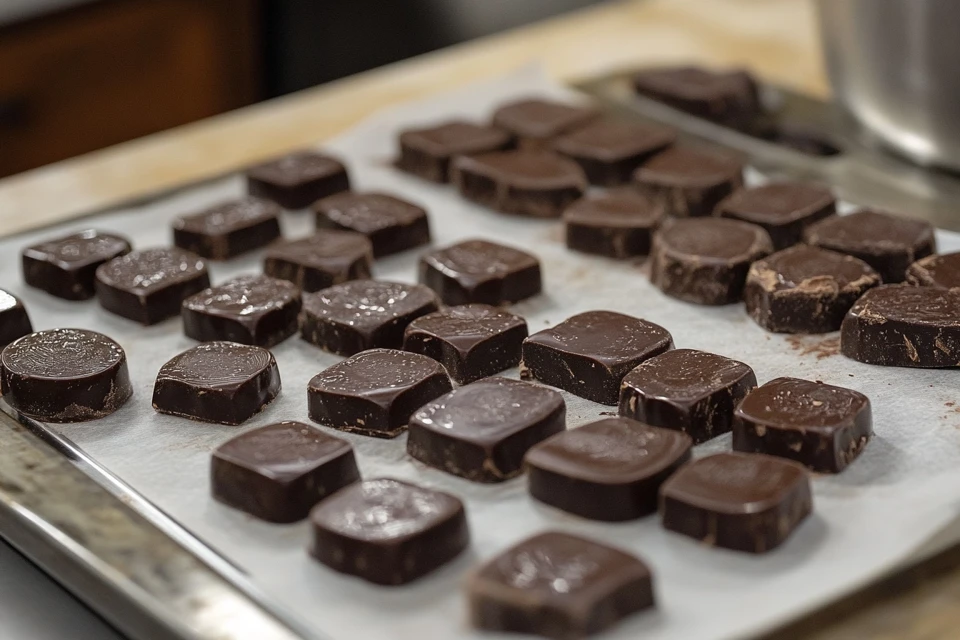Baking with dark chocolate can transform ordinary recipes into rich, indulgent treats. Whether used in cookies, cakes, or brownies, its deep, bittersweet flavor adds complexity and balance to any dessert. In this article, we’ll explore the role of dark chocolate in baking, focusing on how it enhances flavor, texture, and structure.

What is Dark Chocolate?
Dark chocolate is made from cocoa solids, cocoa butter, and sugar, with no added milk solids. Its higher cocoa content compared to milk chocolate results in a more intense flavor. Dark chocolate can vary in cocoa content, ranging from 15% to 100%, with the higher percentages delivering more bitterness.
Dark chocolate comes in several varieties commonly used in baking:
- Sweet Dark Chocolate: Contains 15-34% cocoa liquor and is mild in flavor.
- Semisweet Chocolate: Has 35-64% cocoa liquor and is ideal for most baking recipes.
- Bittersweet Chocolate: Contains 65-98% cocoa liquor and adds a more intense flavor.
- Unsweetened Chocolate: Has 99-100% cocoa liquor, used in recipes where additional sugar is added.
You can explore more about the role of chocolate in recipes, particularly in brownies, by checking out the best dark chocolate brownies recipe for a delicious, fudgy dessert.
How Dark Chocolate Affects Flavor and Texture in Baking
When added to baked goods, dark chocolate contributes more than just flavor—it affects the texture and structure of your dessert as well:
- Balancing Sweetness and Bitterness: The slight bitterness of dark chocolate helps to counterbalance the sugar in recipes, giving a well-rounded flavor.
- Rich Chocolate Flavor: The higher the cocoa content, the more intense the chocolate taste, making it ideal for rich brownies or dense chocolate cakes.
Want to achieve the perfect balance between sweetness and bitterness in your brownies? Consider trying the salted dark chocolate brownies recipe, which uses dark chocolate combined with sea salt for a delightful flavor contrast.

Melting Dark Chocolate for Baking
Melting dark chocolate correctly is key to achieving a smooth texture in your baked goods. Follow these tips for successful melting:
- Double Boiler: This ensures the chocolate melts gently, reducing the risk of burning.
- Microwave in Short Bursts: If using a microwave, melt the chocolate in 30-second intervals, stirring in between to prevent overheating.
For more insight into achieving perfect textures in chocolate-based recipes, check out how dark chocolate plays a role in chewy cookies.
Pairing Dark Chocolate with Other Ingredients
Dark chocolate pairs well with a variety of flavors, enhancing your recipes with both sweet and savory combinations:
- Dark Chocolate and Raspberry: The tartness of raspberries complements the richness of dark chocolate, making for a flavorful dessert.
- Dark Chocolate and Coffee: Coffee deepens the chocolate flavor, making it bolder and more complex.
- Dark Chocolate and Sea Salt: A sprinkle of sea salt brings out the sweetness in dark chocolate while tempering its bitterness.
Looking for a rich chocolate cake recipe that highlights the intense flavors of dark chocolate? Try the chocolate brownie cake, which uses dark chocolate for a fudgy, decadent dessert.

FAQs About Dark Chocolate in Baking
What makes dark chocolate dark?
Dark chocolate has a high percentage of cocoa solids and contains no milk solids, giving it a darker color and richer flavor.
Is dark chocolate bitter?
It depends on the cocoa content. Semisweet chocolate is relatively mild, while bittersweet and unsweetened varieties are more bitter.
Can dark chocolate be used in any recipe?
Yes, but be mindful of the sweetness. Adjust the sugar content according to the type of dark chocolate you use.
What is the best type of dark chocolate for baking?
It depends on the recipe. For cookies, semisweet chocolate works best. For brownies and ganache, bittersweet or unsweetened chocolate adds more depth.
How do you melt dark chocolate without burning it?
Use a double boiler or microwave in short bursts, stirring frequently, to prevent burning or seizing.
By using dark chocolate in your baking, you can elevate the richness and flavor of your desserts, creating treats that are not only delicious but also perfectly balanced between sweetness and bitterness. Whether you’re making cookies, cakes, or brownies, dark chocolate is a versatile ingredient that can transform any recipe into something extraordinary.
Looking for more chocolate-inspired recipes? Explore the ultimate chocolate brownie cake here


2 thoughts on “What Does Dark Chocolate Do in Baking?”